The Persian Regular Army of the First Half of the 19th Century
By Aleksandr Kibovskii and Vadim Yegorov. Translated by Mark Conrad, 1998.
(Part 1, Tseikhgauz [Zeughaus], No. 5, 1996, pgs. 20-25. ISSN 0868-801 X)
While the uniforms of our European opponents are well known, historians have given much less attention to their oriental contemporaries. Seeking to fill this gap, we discuss the Persian regular army which twice clashed with Russia on the field of battle (1804-1813, 1826-1828). The rare archival documents and few published materials we have gathered allow us to present a sufficiently complete picture of the outward appearance of this "exotic" force.
In May of 1807 France and Persia signed the Treaty of Finkenstein, by which Napoleon promised to supply the Persian ruler Fath-Ali-Shah with arms, field artillery, and officers to organize a regular army. It was planned to send to Persia a French contingent of 4000 infantry with 10,000 muskets and 50 cannons. A preliminary mission was sent to the shah, consisting of General Claude-Matthieu Gardane with the first fifteen officer specialists. Napoleon’s instructions (10 May, 1807) to Gardane were to support anti-English and anti-Russian feelings, create a diversion in Georgia, and organize a regular Persian force. On 24 December the mission arrived in Teheran and here set to work. The formation of infantry and artillery units was undertaken in Persian Azerbaidjan - the hereditary possession of the heir to the throne, Abbas-Mirza. The young prince, in opposition to the shah, was distinguished by his bellicosity, and in spite of his defeats by the Russians, among the Persians he passed for a talented military leader. He valued the advantages of a regular army and helped its formation in every way. Regular Persian soldiers were called "sarbaz" (literally, "those who play with their heads", i.e., "risk takers"). Gaspar Drouville in his Travels to Persia in 1812 and 1813 writes that since Abbas-Mirza "did not have the means to give them uniforms, he nonetheless ordered that they have garments sewn up for them of the same color with buttons on the chest, thereby giving them a more warlike appearance." Later, he "ordered that bayonets be put on as many muskets as possible," and finally, "instead of cartridge pouches for their ammunition, each soldier was given a leather bag, fastened in front below the waist, which was as dangerous as it was clumsy."
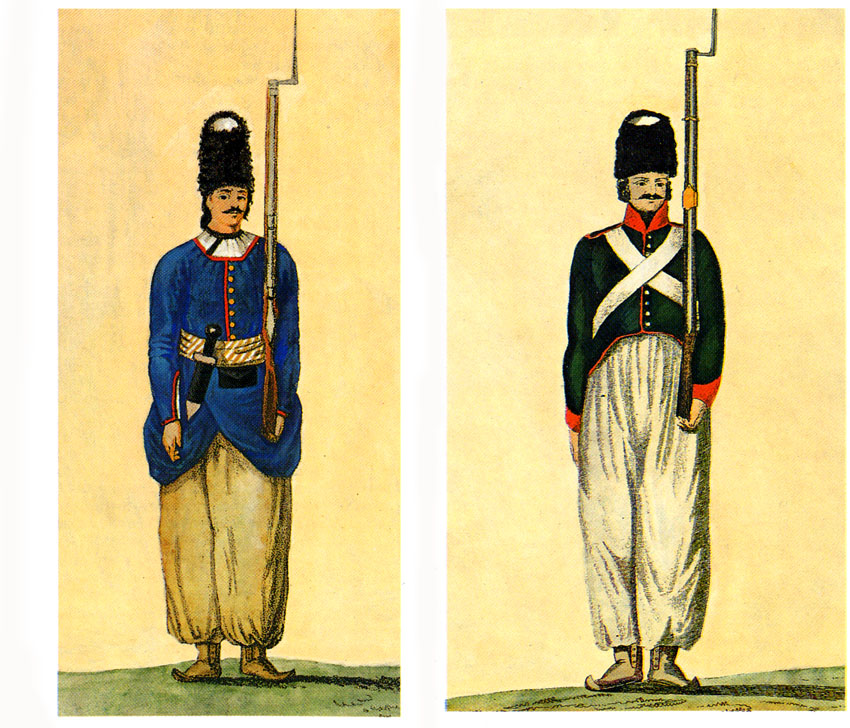
|
|
The earliest "uniforms" Sarbaz. About 1808 (Druvil, 1826). Sarbaz in the initial uniform of the French sample. 1810s. (Druvil, 1826). |
In the meantime, due to the efforts of English diplomats, French prestige began to fall after the peace treaty of Tilsit. At Tilsit, Napoleon said not a word about Persian interests, as at the same time the English promised the shah cannons, muskets, and ten million pounds sterling as "financial aid". As a result, on 16 December, 1809, Gardane and his fellow Frenchmen left Teheran. They were replaced here by the British, mainly officers of the East India Company’s forces. Through India they brought in good-quality English cloth and a great quantity of other equipment, and continued the provision of uniforms to the Persians.
INFANTRY
The sarbaz infantry was the most numerous branch of Abbas-Mirza’s regular forces. Tactically they were divided into "fuadji" (regiments or battalions - here the terms were both used), part of which were quartered in Tabriz, the capital of Persian Azerbaidjan, while the others were considered provincial. In peacetime a private in the sabarz spent half the year on leave to take care of affairs at home. For the other six months he trained with his regiment under the guidance of English instructors. Abbas-Mirza’s new troops impressed Fath-Ali-Shah so much that after 1813 he raised a corps of regular infantry for himself which he called the "djambazy" (literally, "those who play with their souls"). These, however, were much worse soldiers than those of the prince, since they were not trained by British officers, but by men selected from among the sarbazy themselves. Lastly, some sarbaz fuadji became yet another category of regular infantry when the shah ordered that they be raised by nine of his sons who were provincial governors. The sons proved to be unreceptive to European ways, and their warrior tradition was hardly suitable for regular soldiers.
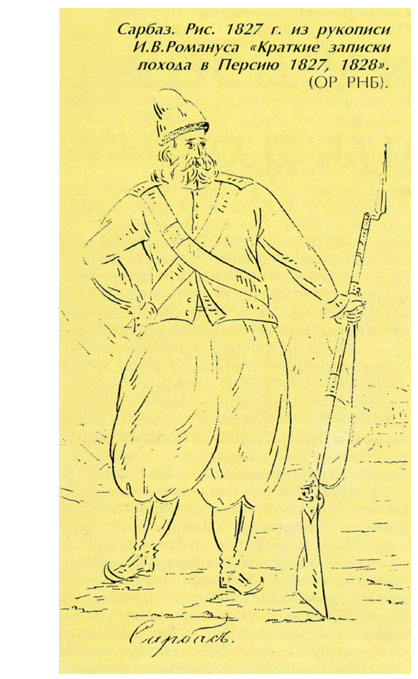
|
| Sarbaz. Picture from a manuscript in 1827, I.V. Romanus "Brief notes, hike in Persia in 1827, 1828" |
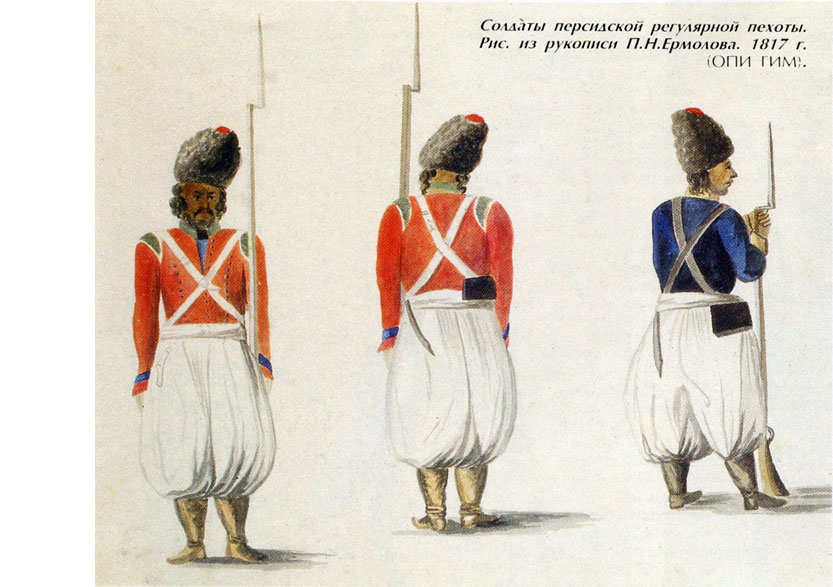
|
| Soldiers of the Persian regular infantry. Picture from Yermolov, 1817 |
Before continuing describing changes in the uniform, we first note that it practically did not change for fifty years. In truth, the main innovation for the sarbaz was their own coat (jacket); everything else was very much like the national Persian costume or a simplification of it. Firstly, it consisted of a headdress - the so-called hat of the Kadjar dynasty, which out of respect for the shah was worn by all of Persia, and which the regular forces did not want to forego for any reason, in spite of all the urgings of the French and English. This hat was shaped like a truncated cone about 30 cm high, and was made from black lamb’s or ram’s fleece, with a small cloth indent on top. To be fashionable, the top of the headdress was a little lower in front.
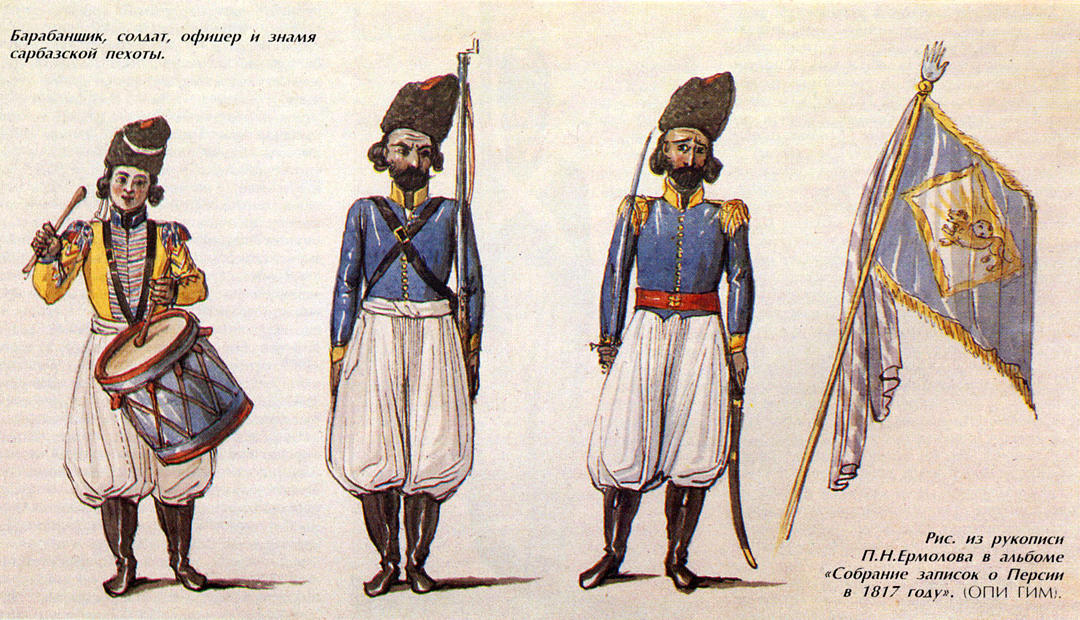
|
| The drummer, a soldier, an officer and a banner sarbaz infantry. Picture from Yermolov, 1817." |
The black karakul of the kadjar hats was in harmony with the Persians’ customs. Men in Persia traditionally wore beards. No doubt to change the aspect of the regular troops at one stroke, the English Major Henry Lindsey ordered razors to be put to the beards, which was done by the overwhelming majority of the sarbaz. The right to wear beards was confined to officers and the djambazy. In all other ways the regular soldier preserved the national hair style, namely: shaved head with a topknot on the crown, and side curls ("zyulfy") on the temples in front and behind the ears (following custom, these were cut off upon reaching age 45). Curls, eyebrows, and even eyelashes were dyed with henna at least once a week.
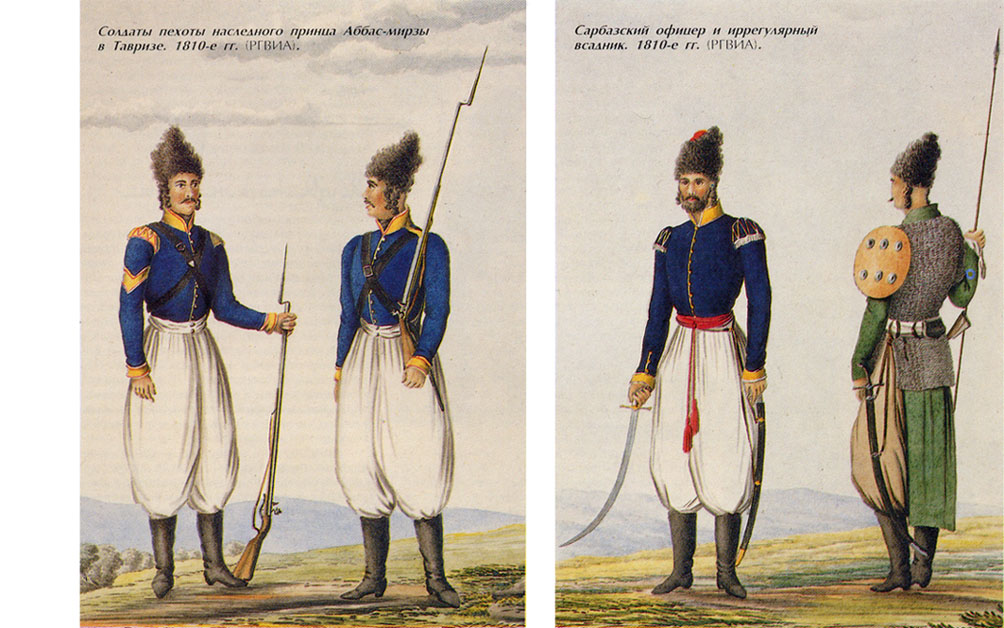
|
|
Soldiers of the Corps of Crown Prince Abbas Mirza in Tabriz. 1810s. Sarbaz officer and irregular horseman. 1810s. Russian State Military History Archive. |
The uniform "pantaloons" of the sarbaz were nothing other than the simple wide trousers called "dzir-djoma" in Persian, reaching to the heels, and lined. These were worn under the shirt and fastened in front with a silk cord. The shirt itself - "piragen" - reached almost to the knees, had no collar, and opened on the left side of the chest. Shirts were made from a silken material in various colors, with trim in different colors if silk cord. Over the undershirt and pants, the Pesians year-round wore a dark, quilted cotton "arkhaluk", somewhat like an 18th-century European coat, and which was buttoned in front and also reached to the knees. In cold weather the outer clothing was supplemented with a short caftan lined with sheep’s fleece. It had sleeves to the elbows, but was not even buttoned, but simply tied with a sash. Sashes were wool, cotton, or cashmere silk, depending on availability. Kindjal daggers were thrust in the sash, with soldiers and civilians both preferring the straight "Georgian" (i.e., Caucasian - Auth.) style, often with rich decoration.
Combining these oriental pieces of costume with their single-breasted uniform coats, the sarbaz first tucked the shirt into the pants, and then the arkhaluk, so that when training it was hard to move their legs. Others wore the shirt pulled out, and it billowed out from under the jacket. Much commotion was caused by European boots and unfamiliar leather accouterments...
There was no definite regulation in regard to color for the uniform, which was due to insufficient supplies of cloth, as well as the Persian’s disinclination to complicate their lives. Captain P. N. Yermolov, investigating the state of their armed forces, in 1817 wrote, "Persian infantry is clothed in cloth jackets, of different colors for each battalion (many battalions are clothed in red), the collar and cuffs are of a different color than the coat. Wide pants are of white cotton; boots are of European style. On their heads is the usual Persian ram’s fleece hat... Neckcloths are worn by those who so wish... Vekils have three yellow cloth chevrons on their sleeves, Mubashirs have two chevrons, and dakhbashs have one (the reference here is to sergeants, supply NCOs, and corporals - Auth.). The infantry does not have greatcoats or packs, but in cold and rainy weather, anyone can wear what they want over the coat.
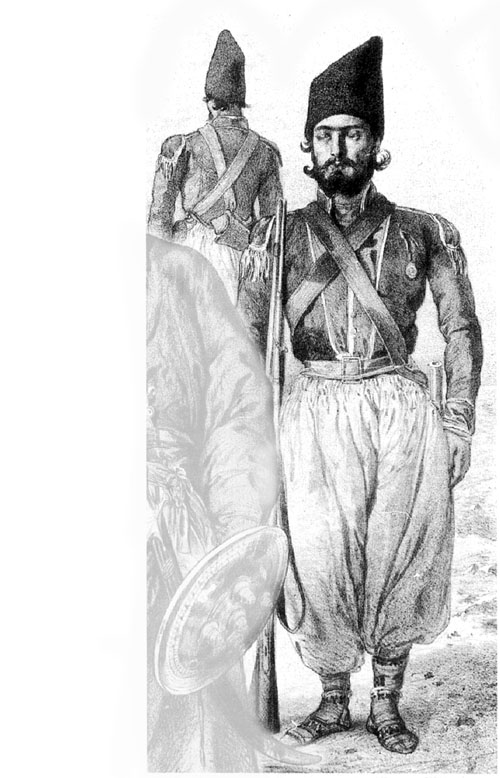
| ||
| Soldiers of the regular infantry. Detail of lithograph after a drawing from life by J. Laurent. 1852 |
"The infantry is armed with English muskets with bayonets... non-commissioned officers and privates do not wear sabers or short swords. In some battalions, privates are allowed to wear daggers... They have a cartridge pouch on a belt worn from the left shoulder down to the right, and which is further held by a small belt going around the waist. On another belt over the right shoulder to the left they wear a frog for the bayonet. In each battalion these crossbelts are either black leather or white deerskin, but no one attaches any significance to this."
Yermolov also noted that the purchase of cloth from the East India Company at high prices was a "burden" for the Persians, so they were going to set up their own textile factories, and the troops would sew their own English uniforms from the planned product of these establishments.
In later times the situation was unchanged. Colonel F. F. Bartolomei wrote of three infantry regiments he saw in 1826 that they had wide white pants but different colors for the coat - red, blue, and green. Baron F.F. Korf, secretary for the Russian mission in 1834-1835, mentioned the sarbaz’s black ram’s fleece hat, red single-breasted coat with wide skirts which had a "baggy" fit, and wide white pants "gathered at the bottom and fastened at mid-calf with straps from the shoes as a kind of sandal" (obviously, an "irregular" type of footwear - Auth.). "A swordbelt and crossbelt that cross over the chest, and a large musket, the weight of which appears to bear him toward the ground," Korf concludes humorously.
In 1837 the Persian army moved against Herat. The Russian Colonel I. F. Blaramberg, who was gathering statistical information on Persia, tells us this about the expedition: "The clothing of the regular Persian troops is known: cloth jacket, wide white cotton pants fastened above the ankles by boots with high stockings, while the "popakh" or Persian hat is of ram’s wool. Sarbaz usually wear their peasant clothing underneath the jacket, and tuck the skirts of the caftan into the above-mentioned pants. There is no regulation concerning uniform colors; these depend on what cloth is able to be procured. As a consequence, the regiments are clothed in different colors; only the guards regiments usually wear a red uniform. The cartridge pouch is small and similar to ours, with a crossbelt that crosses the chest over another belt that carries the bayonet scabbard. A wide strap with a buckle serves as a waist belt and helps hold the crossbelts so that they do not swing about. Up to now knapsacks are unknown in Persia, or at least are not used." Blaramberg further explains that this item, so necessary on campaign, had its place taken by numerous donkeys onto which all loads were packed, so that the sarbazy themselves walked unburdened except for only pouches and muskets over the crossbelts. Muskets were English, with bayonets "without loops" (meaning, apparently, without a fastening mechanism - Auth.). Later in his "observation", Blaramberg mentions "greatcoats", but without any details on what kind of clothing this was.
Years passed... Prince Abbas-Mirza, the founder of the regular army, had died long ago (in 1833), and a year later Fath-Ali-Shah also passed away. His grandson Mohammed followed him on the throne, and then his great-grandson - Naser-ed-Din-Shah. But the sarbaz uniform remained almost the same. For example, in 1857, in connection with the Anglo-Persian conflict (a small war over Herat), the London "Illustrated Times" published an article on the Persian forces in which, in particular, it was written, "The shah’s personal guard wears white trousers, full and pleated, and a red jacket with dark-blue cuffs and collar, while the jackets of provincial troops vary in color," and so on.
The English, who had put so much effort and resources into the regular Persian army, naturally regarded it with tolerance. But Persia’s contemporary potential enemies characterized the sarbaz in very unflattering terms. As early as 1817, Staff-Captain N. N. Murav’ev declared, "This unfortunate infantry, of which they speak of in Europe with respect, was invented to our own benefit. After losing their Asian agility and quickness, the sarbaz have not however acquired European characteristics and are a base and dirty force, badly dressed and created as victims for our grenadiers. They cannot even handle the English muskets which they have been given."
All witnesses speak with one voice in regard to the unfortunate fate of the English muskets: "They are kept in great disrepair."; "...not very clean."; "The majority are defective.", etc. Even in the 1840’s the Persians had not learned to knap flints, but received them from England and Russia. In the summer of 1839 the artist and traveler N. F. Masal’skii observed this kind of scene in camp: "Soldiers in variously colored, torn jackets and wide pants milled about in front of the tents... They hung meat upon their muskets and grilled shashliks on the ramrods." In the fall of that same year he "was witness to an entertaining parade which the Shah made with his guards." The men were wearing "completely new equipment, i.e. red summer jackets and white pants, but everything else was old and dirty! What was even more amusing, was that only the front rank had muskets that still worked; in the next rank behind, and in the third, there was not one good one! You saw a stock with bayonet but no barrel, or a stock with barrel but no bayonet and missing a lock, or simply a barrel with a bayonet... in a word, the most chaotic disorder!" Originally, each private in wartime was to have 100 cartridges, but in reality one was doing well to have 30...
In just as unanimous a voice, writers censure the Persian soldiers for their slovenliness. In 1817 Yermolov wrote, "Every year each of the lower ranks is given a complete new uniform. Nevertheless, there are no troops in the world which can compare with the Persians in untidiness and ill-fitting clothing... One can easily say about the uniforms that their wear-out period is longer than a year, since of all the troops that we have seen here not one battalion had good clothing, and one can see that the climate is as much a cause as the slovenliness of the Persians." Even Abbas-Mirza’s guards who were "in clothing that was rather good (especially their hats)" were "noticeably negligent in caring for it" (Bartolomei, 1826). In the 1830’s, according to Blaramberg, the wear-out periods were changed somewhat: "The renewal of uniforms was prescribed to be every two years, while new greatcoats were issued to non-commissioned officers, drummers, and soldiers every three years. Every year they also receive two pairs of boots each, or instead of this - 2 1/2 saibkras" (in Russian money - 3 paper roubles -Auth.). These conditions were comparatively generous and similar to norms for issuing clothing in European armies. Nonetheless, as Blaramberg again wrote in 1837 from Herat, only a few infantry battalions had an excellent appearance, "the rest of the sarbazy wore torn uniforms or ragged peasant dress."
OFFICERS
"Persian officers - very amusing fellows," judged one contemporary. Their uniform was hardly different from that of the soldiers’ as they themselves attached little significance to it. "Officers," wrote Yermolov in 1817, "have epaulettes on the shoulders, with silver or gold fringes (apparently, this is in regard to British-style epaulettes - Auth.). Except when in formation they do not wear their uniform, but rather are always in traditional Persian dress." Their sole weapon was a saber, the majority of which were Persian with curved blades. Bartolomei, who observed Kasum-Khan’s guards battalion training in 1826, also noted that "officers are distinguished from the soldiers by red sashes and beards," and even the sons and nephew of Abbas-Mirza, who were serving in this battalion, wore soldiers’ coats of coarse cloth, but while not on duty - their traditional dress. When he wished to give a present to the princes, the head of the Russian embassy, Prince A.S. Menshikov, on 15 June, 1826, ordered Colonel Bartolomei to buy for them in Tiflis gold field-grade officers’ epaulettes. The task was performed, and from that time on Russian epaulettes quickly spread among the Persian officer corps. From the British they borrowed the frock coat "nizam", which they undertook to decorate after their own tastes. "Their clothing consists of a frock coat reaching to the knee, with embroidered collar and large epaulettes; pants are tucked into the boots, and they have ram’s fleece hats," wrote Korf about Persian officers (1834-1835).
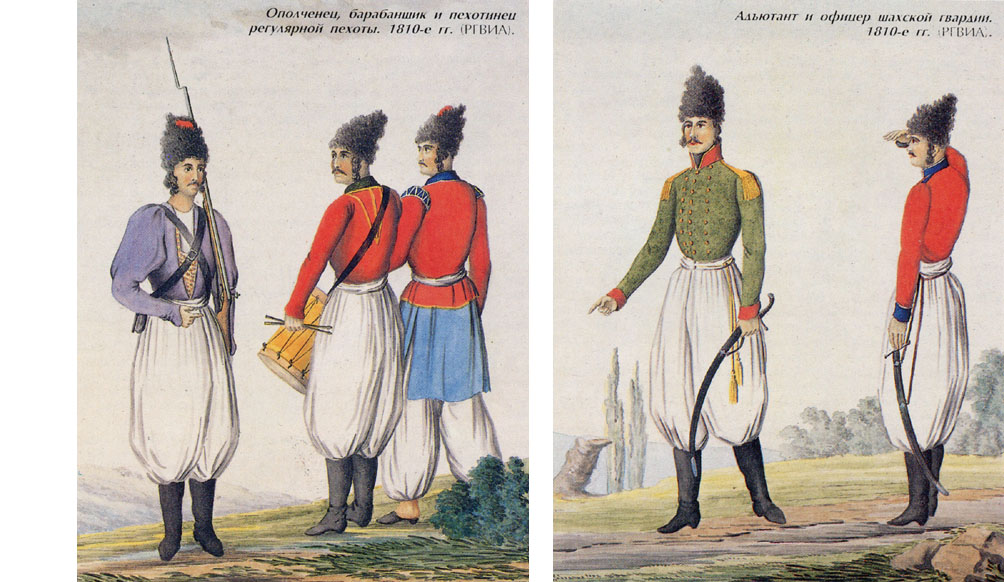
|
|
Militiaman, a drummer and regular infantryman. 1810s. The adjutant and officer of the shah's guards. 1810s. Russian State Military History Archive. |
The next information is Blaramberg’s, relating to the time of the siege of Herat in 1837: "No regulation uniform has been introduced for officers. Field-grade officers usually wear red caftans like a kind of frock (nizam), even though their regiment’s uniforms are of a different color. The collar and cuffs on the sleeve are trimmed in gold. This embroidery is imported from Georgia, just as the epaulettes. However, field-grade officers more often wear the uniform coat when they are serving with their regiments. Company-grade officers are distinguished from soldiers by a thin crimson silk sash, or only by the fact that they do not have a musket. However, recently the majority of them are also wearing epaulettes of the same type which are regulation in Russia." All this shiny finery, naturally, was not regulated in any way. K. K. Bode, the first secretary of the Russian embassy, saw one Persian serkheng (colonel) in the 1830’s who "decorated himself... with collar and cuffs of black velvet with thick silver embroidery, which must have been taken from the coat of Griboedov", killed in Teheran in 1829.
In a word, Persian officers did not attach any special significance to the word "uniform" and considered it only as a variation of formal clothing. In this regard the English instructor Garton adopted the same native attitude as His Majesty Mohammed-Shah (son of the late Abbas-Mirza). The first walked about with a cane, "in a red frock coat of his own design (he termed it his ‘uniforme de phantaisie’)", wearing a Russian shako bought in Tiflis and ornamented with a St.-Andrew’s star inscribed in Russian "For Faith and Fidelity" (Bartolomei, 1826). The parade uniform of His Majesty was a nizam "like a kind of cossack half-caftan, dark blue, with collar and cuffs embroidered with brilliants, emerald buttons, and epaulettes like a general’s, also of large emeralds with big pearls sewn to it with thread" (A. D. Saltykov, 1838).
One more incident demonstrates the cavalier attitude of the Persians towards uniforms. In 1829, in Moscow, Prince Khazrev-Mirza, the head of the Persian embassy, being enthralled by Russian military uniforms, "by some means obtained a Russian uniform coat, and one afternoon wore it to go out walking; but Major General Rennenkampf, who was accompanying him, successfully advised him against it. Nonetheless, at night he managed to travel forth in this uniform and was at Kozikh in a public house" (out of curiosity), etc. [Note: A number of documents concerning Khazrev-Mirza’s stay in Russia were graciously shown to the authors by the scholar M. V. Sidorova, manager of the GARF inventory office.]
In conclusion we add that the princes were always rendered their due honors, while the ordinary sarbaz officer lost all his authority over the soldiers once they were not in formation. The soldiers had no wish to salute him - it was only epaulettes and pay that distinguished him from them. [Note: The available material plainly shows that the European details of the uniforms of the Persian regular infantry - the leather equipment, jackets with shoulder wings and lace, non-commissioned officers’ chevrons, officers’ crimson sashes with tassels, and hussar boots - were obviously in the style of British light infantry.]
FLAGS
In 1813, Fath-Ali-Shah, who was visiting Azerbaijan, personally delivered the first flags to the regular infantry. According to Drouville, these flags were red and decorated with white tafetta edges with gold fringes. On the top of the pole was a silver hand. The cloth "had the coat of arms of their country, which is to say a lion lying in front of a rising sun, with the inscription ‘Sultan, son of the Sultan Fatei-Ali, Emperor descended from the Kadjars’" (Abbas-Mirza’s title - Auth.). Blaramberg (1837) repeats Drouville, when at Herat he saw that "the regimental flags were all the same, i.e., shafts topped by a silvered hand (the hand of Ali), while the flag itself was of red cloth or silk with a rising sun over a reclining lion (the Persian national emblem)." To be sure, when Blaramberg was later referring to these same events, he made a mistake or, on the other hand, was more specific: "Each Persian regiment has its own silk flag - red, white, yellow, and so on as desired", but invariably with the lion, sun, and silver "hand of Ali" (Ali ibn Abu Talib - warrior of Islam, one of the prophet Mohammed’s first followers and his son-in-law, especially venerated in Persia - Auth.).
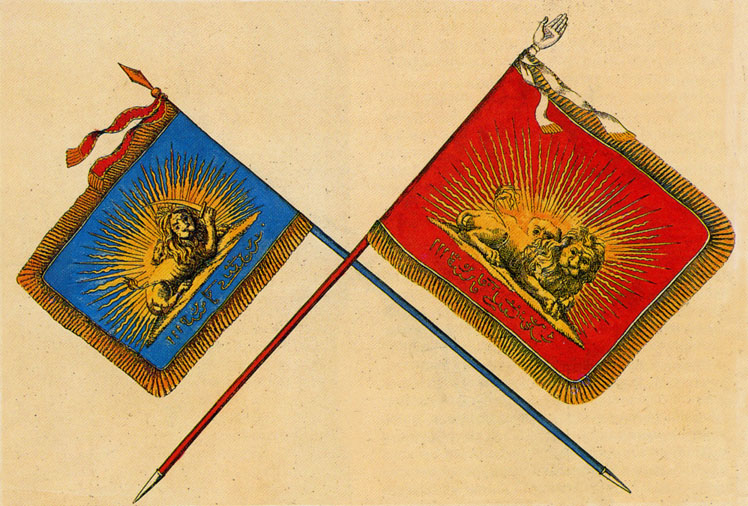
|
| The cavalry standard and infantry colors of regular troops. 1810s. (Druvil, 1826). |
MUSICIANS
"The flag with the Persian coat of arms," noted N. N. Murav’ev in his notes (1817), "stands in the middle of the battalion with the musicians dressed in yellow jackets. These musicians consist of drummers, fifers, and trumpeters. The first beat the drum well, but the second, who have not the least natural talent for music or any understanding of rhythm, play so that it is only with difficulty that one can recognize it is ‘God Save the King’ that they are tooting." In the same year, Yermolov wrote, "Drummers and fifers are dressed in either red or yellow coats, with lace on the seams and arms, white cords on their caps, with a tassel hanging over the right shoulder." In later years the uniforms of musicians remained just as colorful.
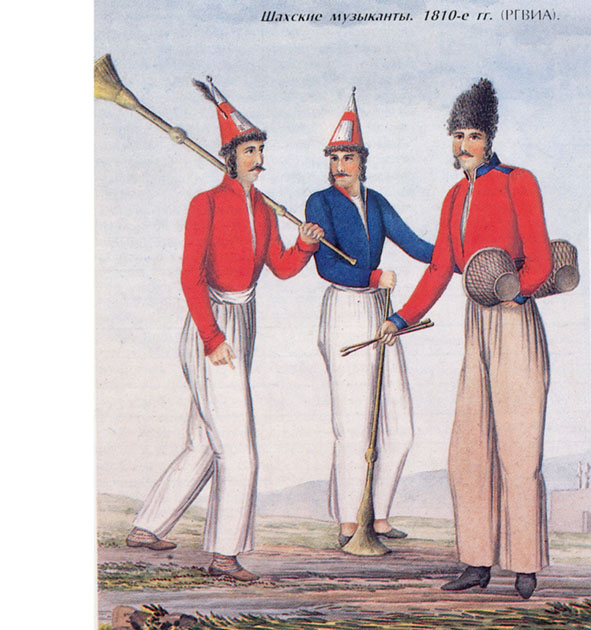
|
| Shah's musicians. 1810s. Russian State Military History Archive. |
On the march, in order to give themselves relief, they tied the drums to the backs of donkeys, and when rendering honors during mounting of the guard they played the English anthem "God Save the King" as before, but, however, as it also arranged at that time in Russia (Bartolomei, 1826).
MEDALS
In order to decorate soldiers and officers of the regular army with something else besides monetary awards, in 1806 silver and gold medals were instituted. These medals appeared to be lesser grades of the Persian Order of the Lion and Sun. But while this order could be received for civilian services, the medals were only for military deeds. Also, the Persian shahs were very active in giving out this order to foreign military men, diplomats, etc., but were extremely reserved in awarding it to their own subjects. Only noble or specially distinguished magnates close to the shah’s court might count on receiving an order. Thus, the only award for soldiers, and the basic award for officers, were medals. One of the first of these drew the attention of the British politician John Malcolm. After visiting Persia in 1800, 1808, and 1810, in 1815 he produced the monumental work "History of Persia". In it, Malcolm devoted considerable attention to Persian governmental symbols. Examining, in particular, the image of the reclining lion with the sun rising from behind his back, he notes that this symbol is embroidered on regimental flags (see above) and is present on the regalia of orders. For those who distinguished themselves fighting against foreign enemies, the order was issued in the form of a gold or silver medal. Malcolm has a very interesting small footnote: "The medals which are struck with this symbol (the lion and sun - Auth.) are primarily given to Persian officers and soldiers of the regular forces who have distinguished themselves in the war with Russia. English officers who recently served in the Persian army have told me that those (Persians) who have been awarded such medals are extremely proud of these decorations, and overall everyone strives very hard to receive one." Drouville, who was in Persia in 1812 and 1813, substantially supplements Malcolm: "The prince rewards his soldiers as in Europe, with rank, orders, and money. He convinced his father to institute many classes of the Order of the Lion and Sun. These various classes are: first - silver medals for non-commissioned officers and soldiers, carrying with it a stipend of two rupees a month (five francs); a gold medal for officers, which comes with ten rupees..." In 1827, the Russian officer I. V. Romanus drew one of the sarbaz medals in detail. Apparently, it was intended that the djambaz would receive similar medals, but supposedly with lines praising Abbas-Mirza (see illus.). The medals were worn on the left side of the chest, on a ribbon that most often was the same as that of the ribbon of the medals of the Order of the Lion and Sun. Drouville wrote that "their ribbons were changed many times; the French first wore their Orders of the Sun on crimson ribbons, then the color was orange. Finally, the Emperor (Shah - Auth.) settled on green, it being the favorite color of their Prophet." However, for example in I. G. Spasskii’s book "Foreign and Russian Orders Up To 1917", the following information is given: "For foreigners awarded medals of the second class and lower, it was prescribed to have a green ribbon, and for subject citizens - a light-blue one." It is apparent that medals were awarded in subsequent times.
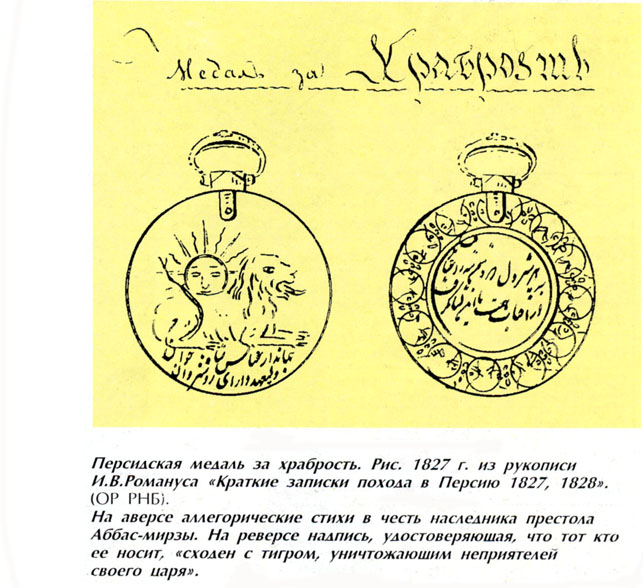
|
| Persian medal for bravery. Picture from a manuscript in 1827 I.V. Romanus "Brief notes, hike in Persia in 1827, 1828." |
Illustrations: Page 20: Cavalry standard and infantry flag of the regular forces. 1810s (from Drouville’s book).
Page 21: (Top) The earliest "uniform" of the sarbaz. About 1808 (from Drouville’s book).
(Bottom) Sarbaz in the first French-style uniform, 1810s (from Drouville’s book).
Page 22: (Top) Sarbaz. Illus. from 1827 from I.V. Romanus’s manuscript Short Notes on the Campaign in Persia 1827, 1828. Russian National Library.
(Bottom) Drummer, officer, and flag of sarbaz infantry. Illus. from P. N. Yermolov’s manuscript in the album Collection of Notes on Persia in 1817. State Historical Museum.
Page 23: (Left) Infantry soldiers of Crown Prince Abbas-Mirza in Tavriz. 1810s. Russian State Military History Archive.
(Right) Sarbaz officer and irregular horseman. 1810s. Russian State Military History Archive.
Page 24: (Top) Soldiers of regular Persian infantry. Illus. from P. N. Yermolov. 1817. State History Museum.
(Bottom left) Militia man, drummer, and infantryman of the regular infantry. 1810s. Russian State Military History Archive.
(Bottom right) Adjutant and officer of the Shah’s guards. 1810s. Russian State Military History Archive.
Page 25: (Top) Soldier of the regular infantry. Part of a lithograph based on a drawing from life by J. Loran. 1852.
(Bottom left) Musicians of the shah. 1810s. Russian State Military History Archive.
(Bottom right) Persian medal for bravery. Illus. from 1827 from I. V. Romanus’s "Short Notes on the Campaign in Persia 1827, 1828". Russian National Library.
On the front are allegorical lines in honor of Abbas-Mirza, the heir to the throne. On the reverse is an inscription averring that the wearer is "like a tiger, destroying the enemies of his emperor."
(End of Part One.)
*****************************
Sources Studio Siberia and Translation by Mark Conrad
See also Part 2: The Persian Regular Army of the First Half of the 19th Century, by Aleksandr Kibovskii and Vadim Yegorov. Translated by Mark Conrad
"Bagaderan" - Russian Deserters In The Persian Army, 1802-1839, by Aleksandr Kibovskii. Translated by Mark Conrad
Persian 19th Century Soldiers
Persian Illustrations of Costume & Soldiers
